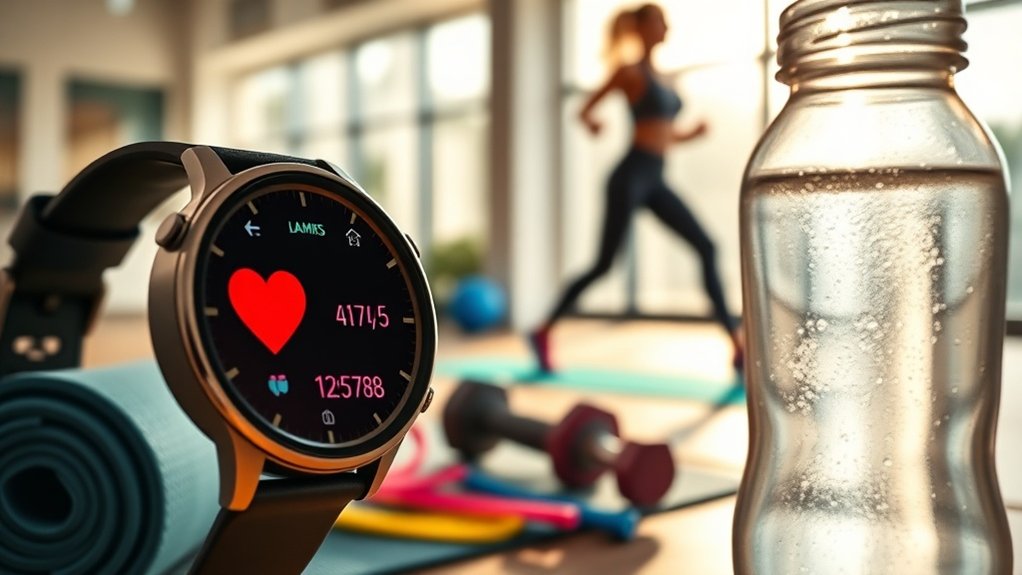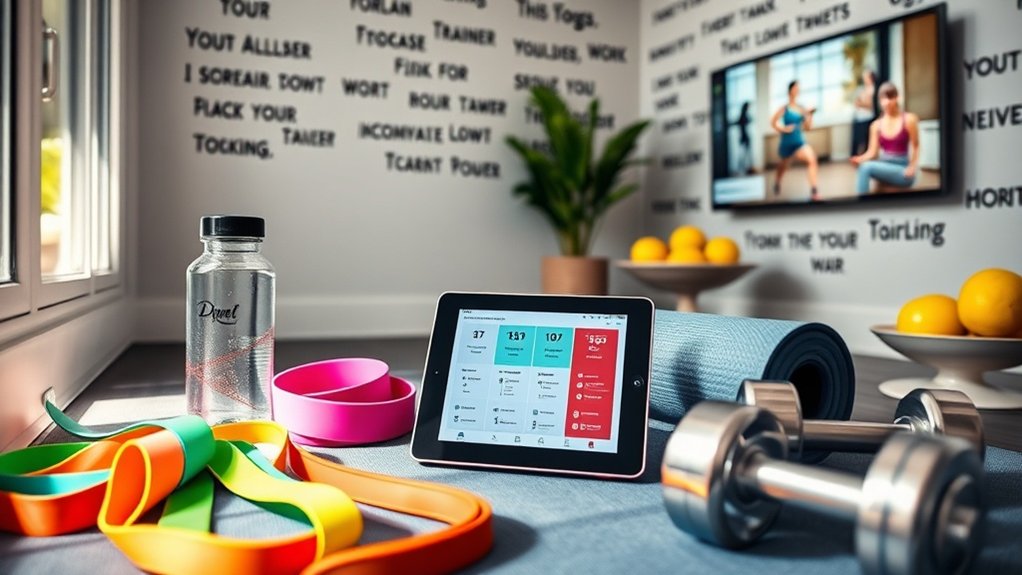To create a personalized cardio plan that strengthens your heart, you’ll calculate your target heart rate by subtracting your age from 220, then multiplying by 0.50-0.85 based on your fitness level. Aim for 150 minutes of moderate-intensity aerobic exercise weekly, progressing toward 300 minutes for ideal cardiovascular protection—this approach reduces your disease risk by 20-50%. You’ll track improvements through declining resting heart rate and improved workout capacity, while combining varied activities like cycling, swimming, and running. The following sections provide specific protocols for implementing these evidence-based strategies.
Understanding Heart Rate Training Zones for Optimal Cardiovascular Benefits

When you exercise without understanding your heart rate zones, you’re fundamentally training blind—missing opportunities to maximize cardiovascular benefits while potentially overexerting yourself.
Heart rate training zones divide exercise intensity into five categories based on percentages of your maximum heart rate (calculated as 220 minus your age). Each zone serves distinct physiological purposes: the Fat Burn Zone (60-70%) optimizes fat metabolism for weight management, while the Aerobic Zone (70-80%) strengthens your heart and lungs.
The Orange Zone (84-91%) delivers significant cardiovascular adaptations when you maintain it for 12-20 minutes. This systematic approach transforms generic workouts into precision tools.
You’ll train at intensities that align with your specific goals—whether building endurance, burning fat, or improving cardiovascular capacity—while protecting against overtraining.
Calculating Your Target Heart Rate Based on Age and Fitness Level
To determine your personalized target heart rate, you’ll need to apply the standard formula: subtract your age from 220 to establish your maximum heart rate, then calculate 50-85% of that number.
A 30-year-old, for instance, would have a maximum heart rate of 190 bpm and should maintain 95-162 bpm during exercise for ideal cardiovascular benefits.
Your specific target range within this zone depends on your current fitness level—beginners should start at the lower end (50-60%), while more conditioned individuals can safely work toward the upper range (70-85%).
Age-Based Heart Rate Zones
Your maximum heart rate forms the foundation for creating safe and effective cardiovascular exercise targets. Calculate it by subtracting your age from 220, then apply age-based heart rate zones to optimize your workouts.
Your personalized heart rate zones guide training intensity:
- Moderate-intensity zone (50-70%): You’ll maintain conversation while walking briskly or cycling leisurely, building endurance without excessive strain.
- Vigorous-intensity zone (70-85%): You’ll experience increased breathing during jogging or swimming, maximizing cardiovascular benefits.
- Regular assessment intervals: You’ll track improvements every 4-6 weeks, adjusting zones as your fitness advances.
- Safety parameters: You’ll avoid exceeding 85% during standard workouts, preventing overexertion and injury.
Understanding age-based heart rate zones guarantees you’re exercising at appropriate intensities, delivering measurable cardiovascular improvements while maintaining safety throughout your fitness journey.
Personalizing Your Target Range
Calculating your target heart rate requires two simple steps that transform general guidelines into your specific training parameters. First, subtract your age from 220 to establish your maximum heart rate. Then multiply this number by 0.50 and 0.85 to define your personalized training zone.
| Fitness Level | Recommended Intensity Range |
|---|---|
| Beginner | 50-60% of maximum |
| Intermediate | 60-70% of maximum |
| Advanced | 70-85% of maximum |
| Athletic | 80-85% of maximum |
Your fitness level determines where you’ll position yourself within this range. Beginners should target lower percentages to build cardiovascular capacity safely, while conditioned athletes can sustain higher intensities. Regular monitoring using heart rate monitors or fitness trackers guarantees you’re maintaining ideal intensity throughout your workout, maximizing cardiovascular benefits while preventing overexertion.
Cardiovascular Disease Prevention Through Strategic Aerobic Exercise

When your heart becomes stronger through strategic aerobic exercise, you’re building powerful protection against cardiovascular disease—the leading cause of death worldwide.
Exercise for heart health transforms your cardiovascular system through measurable improvements in blood pressure, cholesterol profiles, and arterial function. Even if you’ve been sedentary for years, middle-aged individuals show remarkable cardiac recovery through consistent activity.
Your strategic approach should include:
- 150 minutes weekly of moderate-intensity activities like brisk walking or cycling to reduce heart disease and stroke risk
- Mixed aerobic activities rotating between different exercises to maintain long-term adherence
- High-intensity interval training sessions delivering maximum cardiovascular benefits in compressed timeframes
- Consistent scheduling that reverses sedentary lifestyle damage and improves heart elasticity
This evidence-based framework provides substantial protection against preventable cardiovascular conditions.
Comparing Cardio Modalities: Running, Cycling, Swimming, Rowing, and Elliptical
Each cardio modality delivers distinct physiological benefits and practical trade-offs that should directly inform your exercise selection. Running and rowing lead cardio training in caloric expenditure at 600-800 calories per hour, though running’s high-impact nature may aggravate joint conditions. Swimming provides thorough muscle engagement at 400-700 calories hourly while protecting vulnerable joints. Cycling’s intensity-dependent burn of 400-1000 calories optimizes leg strength development.
| Modality | Calorie Burn/Hour | Joint Impact |
|---|---|---|
| Running | 600-800 | High |
| Cycling | 400-1000 | Low |
| Swimming | 400-700 | Minimal |
The elliptical simulates running mechanics without skeletal stress, burning 400-600 calories with customizable resistance. Your joint health, fitness objectives, and injury history should guide modality selection within your personalized cardio training program.
Weekly Cardio Volume Recommendations for Heart Health

You’ll need at least 150 minutes of moderate-intensity aerobic activity or 75 minutes of vigorous activity each week to maintain ideal heart health.
These minimum guidelines provide a foundation, but increasing your weekly volume to 300 minutes offers additional cardiovascular benefits and improved disease prevention.
Your personalized plan should incorporate muscle-strengthening exercises on two or more days weekly to complement your aerobic work and support thorough cardiac fitness.
Minimum Weekly Activity Guidelines
Establishing a baseline for cardiovascular exercise isn’t arbitrary—it’s grounded in decades of research demonstrating measurable improvements in heart function, blood pressure regulation, and metabolic health.
The minimum weekly activity guidelines provide clear targets you’ll need to meet for ideal heart health.
Your Weekly Activity Targets:
- 150 minutes of moderate-intensity aerobic activity—brisk walking, cycling on level terrain, or water aerobics that raises your heart rate while allowing conversation.
- 75 minutes of vigorous-intensity activity—running, swimming laps, or cycling uphill that considerably increases breathing rate and heart rate.
- Two muscle-strengthening sessions—resistance training targeting major muscle groups to support cardiovascular function and metabolic efficiency.
- 300 minutes for improved benefits—doubling your aerobic activity amplifies protective effects against cardiovascular disease and mortality risk.
Scaling Up for Benefits
While meeting minimum guidelines protects your cardiovascular system, scaling beyond 150 minutes weekly delivers progressively stronger benefits that researchers have quantified through large-scale population studies. Increasing your activity to 300 minutes offers measurable improvements in heart health, including lower blood pressure, improved arterial function, and reduced cardiovascular disease risk.
| Weekly Minutes | Cardiovascular Benefit | Risk Reduction |
|---|---|---|
| 150 minutes | Baseline protection | 20-30% lower risk |
| 225 minutes | Improved endurance | 30-40% lower risk |
| 300+ minutes | Ideal adaptation | 40-50% lower risk |
You’ll maximize these scaling up for benefits by gradually progressing your duration and intensity. Add 10-15 minutes weekly until you reach your target volume. This measured approach prevents overtraining while systematically strengthening your heart’s pumping efficiency and metabolic capacity.
Progressive Training Strategies to Boost VO2max and Cardiac Output
As you advance your cardiovascular fitness, progressive training strategies become essential for maximizing VO2max—your body’s capacity to use oxygen during intense exercise—and cardiac output, the volume of blood your heart pumps per minute.
Key Progressive Training Strategies:
- Gradually increase workout intensity and duration over weeks to stimulate continuous cardiovascular adaptation.
- Incorporate interval training by alternating high-intensity bursts with recovery periods to improve aerobic capacity.
- Target specific heart rate zones, spending 12-20 minutes in the “Orange Zone” for peak cardiovascular benefits.
- Vary your aerobic exercises among running, cycling, and swimming to engage different muscle groups.
Maintain at least 150 minutes of moderate-intensity activity weekly to sustain long-term heart health improvements and cardiovascular system efficiency.
Monitoring and Measuring Your Cardiovascular Fitness Improvements

Tracking your cardiovascular fitness improvements requires systematic measurement of key physiological markers, particularly your heart rate responses during exercise and recovery.
You’ll need to establish baseline metrics through resting heart rate measurements, target heart rate zone calculations, and initial fitness assessments before implementing your personalized cardio plan.
Technology-enabled monitoring tools, from wearable fitness trackers to smartphone applications, provide continuous data collection that allows you to quantify progress, adjust training intensity, and document measurable improvements in your cardiovascular capacity over time.
Track Your Heart Rate
How can you tell if your cardio workout is truly improving your heart health? When you track your heart rate, you’ll gain measurable insights into your cardiovascular fitness progress. Aim for 50-85% of your maximum heart rate during exercise to optimize cardiovascular benefits.
Here’s what tracking reveals about your fitness improvements:
- Your resting heart rate gradually decreases as your heart becomes more efficient at pumping blood throughout your body.
- Real-time feedback from monitors enables you to adjust workout intensity immediately, making sure you stay within target zones.
- Heart rate recovery speeds up as you become fitter, with your pulse returning to baseline more quickly after exercise.
- Consistent tracking helps you meet the recommended 150 minutes of moderate-intensity or 75 minutes of vigorous-intensity weekly activity.
Measure Progress Over Time
Beyond individual workout sessions, measuring your cardiovascular fitness over weeks and months provides the clearest picture of your heart health trajectory.
Track your resting heart rate weekly—declining values indicate improved cardiac efficiency. Consistently log workout duration and intensity, targeting 150 minutes of moderate-intensity activity weekly while spending 12-20 minutes in the Orange Zone per session.
Fitness trackers integrated with personalized plans deliver real-time feedback, enabling strategic adjustments to optimize results.
As you measure progress over time, you’ll observe tangible improvements: increased stamina, boosted endurance, and better exercise tolerance.
Progressively intensifying your varied activities challenges your cardiovascular system, driving measurable adaptations.
These longitudinal assessments reveal your heart health improvements more accurately than isolated metrics, empowering you to refine your personalized cardio plan based on evidence-based outcomes.
Use Technology and Apps
Modern fitness technology transforms cardiovascular monitoring from guesswork into precise, data-driven assessment.
You’ll gain immediate access to critical performance metrics that reveal your heart’s response to exercise, enabling you to optimize workout intensity and track meaningful improvements in your cardiovascular health.
Technology empowers you through:
- Real-time heart rate monitoring that guarantees you’re exercising within target zones for maximum cardiovascular benefit
- Performance analytics displaying calories burned, workout duration, and heart rate variability patterns
- Personalized workout plans that automatically adjust based on your actual performance data
- Trend identification revealing improvements in endurance and recovery times over weeks and months
These digital tools provide the motivation and structure you need to maintain consistent exercise routines while making informed adjustments to your cardio plan.
Balancing Cardio and Strength Training for Complete Heart Wellness

While cardiovascular exercise strengthens your heart muscle and improves circulation, strength training complements these benefits by increasing lean muscle mass and boosting metabolic efficiency—creating a synergistic effect that’s more powerful than either approach alone.
The American Heart Association recommends you complete 150 minutes of moderate-intensity cardio weekly, combined with muscle-strengthening activities on two or more days.
This balanced approach delivers measurable improvements: lower blood pressure, optimized cholesterol levels, and reduced risks of heart disease, diabetes, and obesity.
As you age, maintaining both cardio and strength training preserves muscle tissue and cardiovascular function, supporting healthy longevity.
You’ll experience improved endurance and functional strength for daily activities, directly improving your quality of life and long-term health outcomes.
Sample Progressive Cardio Programs by Fitness Level
Your cardiovascular fitness level determines the ideal starting point for your exercise program, and selecting the appropriate intensity prevents both undertraining and injury risk.
Progressive Programs by Level:
- Beginner: Walk 20-30 minutes at moderate intensity, three days weekly, gradually building your cardiovascular fitness foundation through consistent, manageable sessions.
- Intermediate: Cycle or swim 30-45 minutes at moderate to vigorous intensity with intervals, 3-5 days weekly, advancing your heart health capacity.
- Advanced: Complete 30-minute HIIT sessions combining sprinting and strength training, four times weekly, maximizing cardiovascular improvements.
- Progression Strategy: Increase workout duration by 5-10 minutes weekly while incorporating rowing or dancing.
Track your heart rate, spending 12-20 minutes in the Orange Zone to optimize cardiovascular benefits and prevent training plateaus.
Tracking Methods and Tools for Heart-Healthy Exercise Success
Because heart-healthy exercise depends on maintaining proper intensity levels, tracking tools transform guesswork into measurable data that protects your cardiovascular system while maximizing workout effectiveness.
Fitness trackers monitor your heart rate in real-time, assuring you’ll still be able to sustain high-intensity interval training within recommended zones that improve heart function and help you build strength.
These devices record workout duration, frequency, and intensity—metrics the American Heart Association emphasizes for reducing heart disease risk and high blood pressure.
You’ll identify patterns showing your fitness journey progress, whether shifting from a sedentary lifestyle or optimizing aerobic activity for overall health.
Tracking calorie burn and distance covered helps adjust your personalized training plan, maximizing cardiovascular benefits that build strength and support a healthy heart, potentially helping you live longer.
Frequently Asked Questions
What Is the Best Cardio Exercise for a Healthy Heart?
The best heart healthy activities include walking, swimming, cycling, and dancing—performed for 20-30 minutes most days. You’ll strengthen your heart, lower blood pressure, and reduce stroke risk when you’re consistent with moderate-intensity aerobic exercise.
What Is the 3-3-3 Rule for Workout?
Need better fitness motivation? The 3-3-3 rule involves performing three different exercise types for three sets of three minutes each. You’ll alternate between strength, cardio, and flexibility movements, creating an engaging, time-efficient workout that boosts heart health.
What Is the 5 4 3 2 1 Workout Method?
The 5-4-3-2-1 workout method structures your exercise into five minutes cardio, four minutes strength, three minutes core, two minutes flexibility, and one minute high-intensity intervals. This workout variability improves cardiovascular fitness while preventing monotony in your routine.
What Is the 3 2 1 Rule in Gym?
Studies show alternating exercise types boosts calorie burn by 30%. The 3-2-1 rule maximizes gym efficiency: you’ll complete three minutes of cardio, two minutes of strength training, and one minute of high-intensity work, optimizing your cardiovascular health systematically.



